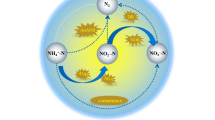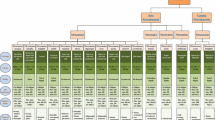Abstract
Rates of nitrification and organic C production were determined in batch and chemostat cultures of marine nitrifying bacteria; two NH +4 -oxidizing species and one NO −2 -oxidizing spezies. With increasing age in batch cultures and with decreasing flow rates in chemostats, cellular organic C and N concentrations declined while the intracellular ratio of C:N remained constant. With decreasing flow rates in chemostats, there was a reduction in (a) carboxylating enzyme activity per unit of cellular organic C (the potential for chemoautotrophic CO2 fixation), and (b) the yield of organic C. For both NH +4 and NO −2 oxidizers, rates of nitrification and C yield were lowest at very slow chemostat growth rates, when compared with optimal growth rates in batch cultures. For both NH +4 and NO −2 -oxidizing species, the stoichiometric relationship between nitrification and organic C production did not remain constant and appeared to be dependent on the availability of the inorganic N substrate. The organic C yield from NH +4 oxidation and hence the free energy efficiency declined with increasing age in batch cultures and with decreasing flow rates in chemostats. The C yield from NO −2 oxidation and the free energy efficiency at slow chemostat growth rates was also lower than that at the optimal growth rate in batch culture.
Similar content being viewed by others
References
Aleem MIH (1970) Oxidation of inorganic nitrogen compounds. Ann Rev Plt Physiol 21:67–90
Baas-Becking LGM, Parks GS (1927) Energy relations in the metabolism of autotrophic bacteria. Physiol Rev 7:85–106
Billen G (1976) Evaluation of nitrifying activity in sediments by dark 14C-bicarbonate incorporation. Water Res 10:51–57
Bull AT (1974) Microbial growth In: Bull AT, Lagnado JR, Thomas OJ, Tipton KF (eds) Companion to biochemistry. Longman, London, pp 415–442
Carlucci AF, McNally PM (1969) Nitrification by marine bacteria in low concentrations of substrate and oxygen. Limnol Oceanogr 14:736–739
Carlucci AF, Strickland JDH (1968) The isolation, purification and some kinetic studies of marine nitrifying bacteria. J Exp Mar Biol Ecol 2:156–166
Glover HE (1983) Measurement of chemoautotrophic CO2 assimilation in marine nitrifying bacteria: an enzymatic approach. Mar Biol 74:295–300
Glover HE, Morris I (1979) Photosynthetic carboxylating enzymes in marine phytoplankton. Limnol Oceanogr 24:510–519
Gundersen K (1966) The growth and respiration of Nitrosocystic oceanus at different partial pressures of oxygen. J Gen Microbiol 42:387–396
Gundersen K, Carlucci AF, Böstrom F (1966) Growth of some chemoautotrophic bacteria at different oxygen tensions. Experientia 22:229–230
Herbert D, Elsworth R, Telling RC (1956) The continuous cultures of bacteria; a theoretical and experimental study. J Gen Microbiol 14:601–622
Hofman T, Lees H (1952) The biochemistry of nitrifying organisms. 2. The free-energy efficiency of Nitrosomonas. Biochem J 52:140–142
Hooper AB (1978) Nitrogen oxidation and electron transport. In: Schlessinger D (ed) Nitrification and reduction of nitrogen oxides. Am. Soc. Microbiol, Washington DC, pp 299–304
Horrigan SG, Carlucci AF, Williams PM (1981) Light inhibition of nitrification in sea-surface films. J Mar Res 39:559–565
Kaplan WA (1983) Nitrification. In: Carpenter EJ, Capone DG (eds) Nitrogen in the marine environment. Academic Press, New York London, pp 139–190
Kelly DP (1971) Autotrophy: Concepts of lithotrophic bacteria and their organic metabolism. Ann Rev Microbiol 25:177–209
Kelly DP (1978) Bioenergetics of chemolithotrophic bacteria. In: Bull AT, Meadow PM (eds) Companion to microbiology. Selected topics for further study. Longman, London, pp 363–385
Kelly DP (1981) Introduction to the chemolithotrophic bacteria. In: Starr MP, Stolp H, Trüper HG, Balows A, Schlegel HG (eds) The prokaryotes. Springer, Berlin Heidelberg New York, pp 997–1004
Koops HP (1969) Der Nutzeffekt der NH +4 -Oxydation durch Nitrosocystis oceanus Watson. Arch Mikrobiol 65:115–135
Krümmel A, Harms H (1982) Effect of organic matter on growth and cell yield of ammonia-oxidizing bacteria. Arch Microbiol 133:50–54
Laudelout H, Simonart PC, Droogenbroeck R (1968) Calorimetric measurement of free energy utilization by Nitrosomonas and Nitrobacter. Arch Microbiol 63:256–277
Müller-Neuglück M, Engel H (1961) Photoinaktivierung von Nitrobacter winogradskyi. Arch Mikrobiol 39:130–138
Olson RJ (1981) Differential photoinhibition of marine nitrifying bacteria: a possible mechanism for the formation of the primary nitrite maximum. J Mar Res 39:227–238
Painter HA (1970) A review of the literature on inorganic nitrogen metabolism in microorganisms. Water Res 4:393–450
Pirt SJ (1965) The maintenance energy of bacteria in growing cultures. Proc Roy Soc B 163:224–231
Schön G (1965) Untersuchungen über den Nutzeffekt von Nitrobacter winogradskyi (Buch). Arch Mikrobiol 50:111–132
Strickland JDH, Parsons TR (1972) A practical handbook of seawater analysis, 2nd edn. Bull Fish Res Bd Can 167:1–310.
Suzuki I (1974) Mechanisms of inorganic oxidation and energy coupling. Ann Rev Microbiol 28:85–102
Watson SW, Mandel M (1971) Comparison of the morphology and nucleic acid composition of 27 strains of nitrifying bacteria. J Bac 107:563–569
Watson SW, Waterbury JB (1971) Characteristics of two marine nitrite oxidizing bacteria, Nitrospina gracilis nov gen nov sp and Nitrococcus mobilis nov gen nov sp. Arch Microbiol 77:203–230
Whittenbury R, Kelly DP (1977) Autotrophy: A conceptual phoenix. Symp Soc Gen Microbiol 27:121–149
Williams FM (1971) Dynamics of microbial populations In: Patten BC (ed) System, analysis, and stimulation in ecology. Academic Press, New York London, pp 197–267
Author information
Authors and Affiliations
Rights and permissions
About this article
Cite this article
Glover, H.E. The relationship between inorganic nitrogen oxidation and organic carbon production in batch and chemostat cultures of marine nitrifying bacteria. Arch. Microbiol. 142, 45–50 (1985). https://doi.org/10.1007/BF00409235
Received:
Accepted:
Issue Date:
DOI: https://doi.org/10.1007/BF00409235




